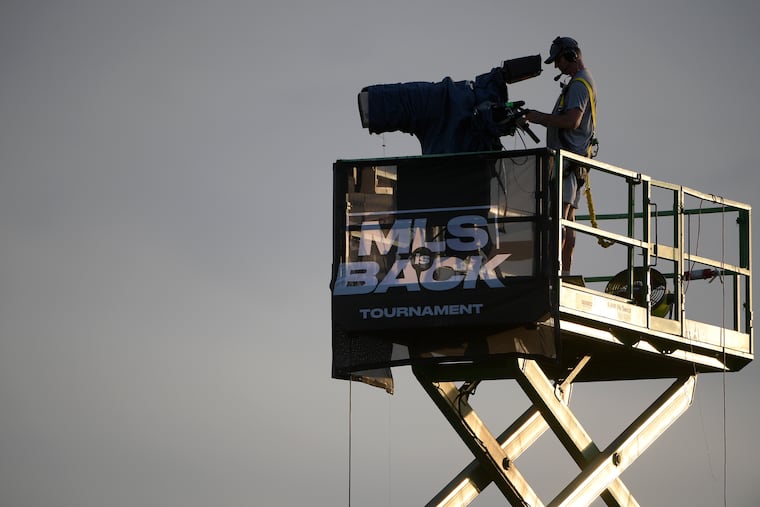MLS tournament TV ratings haven’t been great, but ESPN’s technology has been a winner
The league said viewership this month is up 7% over July 2019, but beyond that things aren't as rosy. Viewers who have tuned in have seen neat technological innovations, highlighted by a drone camera and microphones in the field.

Friday was the first day without games in Major League Soccer's summer tournament since the event kicked off on July 8. With 36 contests over 16 days, there wasn't much time for executives at the league to take an overall view of what was going right and what was going wrong. And that's before counting the many games that were postponed or canceled because of Nashville SC and FC Dallas' coronavirus outbreaks.
As the group stage came to an end, MLS senior vice president of media Seth Bacon finally had time to step back and survey the scene. And like many things in the league, it looks like a page from a Rorschach test.
The league said Thursday that MLS’ viewership this month is up 7% over July 2019, which counts for something because the league traditionally gets its biggest spotlight in mid-summer. The average viewership for the prime time games is 289,000 viewers, a 4% increase over last year as a whole. The tournament’s biggest audience was 639,000 viewers for Atlanta United-New York Red Bulls on July 11, which aired on Fox’s broadcast network and Univision’s cable channel TUDN.
But beyond that, things aren’t as rosy. Some of the smallest audiences have come for the 9 a.m. kickoffs, which were set up to avoid the worst of Orlando’s summer heat. The league and ESPN — which aired all nine of those games in the tournament — thought they would do well. So did many soccer fans who are used to waking up early to watch games from European leagues.
Alas, the morning window has been a TV flop. ShowBuzz Daily and the Sports Business Journal reported that the biggest audience for any of them has been 175,000.
"We were curious to see what would happen in these windows," Bacon said. "Clearly, playing games at 9 a.m. on a weekday, there's a lot of learnings we can take from that. But it's an experiment, it's something we've never done before, so we understand things that we didn't before."
The biggest success with broadcasting the tournament has come from the many new technologies that MLS and ESPN have deployed. Among the most obvious is the virtual advertising wall on the sideline that has been covered with local and national sponsors.
Bacon said the walls at each of the three fields span 300 feet by 15 feet, and are weighed down by around 80,000 pound of concrete. Around 200 different items get loaded into the display system for each game, covering everything from the Union’s local partners to Canadian brands that only show up for Canadian broadcaster TSN.
"It's an expensive undertaking, and, for sure it's been one that [has] returned great dividends both from an economic standpoint but also just from a partnership standpoint," Bacon said. "We were able to deliver on that in a way that exceeds even our expectations."
He wouldn't get into financial specifics, but the volume of ads visible on every broadcast certainly gets attention.
From the broadcast side, the most acclaimed aspect has been the drone camera that flies high over the field at every game. It has provided some fascinating views of formations and teams' tactical moves.
And it hasn't just been seen on ESPN's broadcast. Because the network's staff is producing the host feed that goes out to Fox, Univision and the entire world, the drone camera shots have been available to everyone.
So when TUDN's broadcast of the Union-Inter Miami game showed the drone's view of the Union's outstanding counter-attack goal, ESPN's staff were at the controls. Producer Matt Leach and director Bob Frattaroli, two of the network's soccer veterans, oversaw the broadcast.
ESPN’s senior coordinating producer Amy Rosenfeld also noted a few other technological innovations that have gone over well, such as a small camera behind a net that can nestle into holes in the twine. One of those delivered a perfect view of a goal by Los Angeles FC’s Bradley Wright-Phillips on Thursday that flew within inches of the lens.
On the audio side, microphones in the field have picked up all manners of fascinating sound, especially players and coaches shouting instructions [and a few expletives]. The diversity of MLS is such that there’s been as much Spanish as English, and a healthy dose of French too.
"The coaches and players have really bought into [the idea] that this is an opportunity to immerse the audience if the audience can't be here," Rosenfeld said.
Her top priority, though, has been the health and safety of a production crew she said is somewhere between 175 and 200 people. They've all remained virus-free so far, and have done their part with social distancing.
Rosenfeld has been a leader of ESPN's soccer team for nearly 20 years now, with experiences ranging from riots at Euro 2016 in France to floating a production truck on a barge in 2004 for a U.S. men's World Cup qualifier at Grenada.
This summer hasn't required any exotic travel, but she said it's "up there as one of the hardest events some of us have done."
“Because of the unknown of doing television and being some of the first out of the gate, hats off to MLS for pulling this off,” Rosenfeld said. “Being able to broadcast sports television in a global pandemic safely, it is not easy. So I’m really proud of what’s been on the screen, but even more proud of the team that’s doing it behind the scenes.”